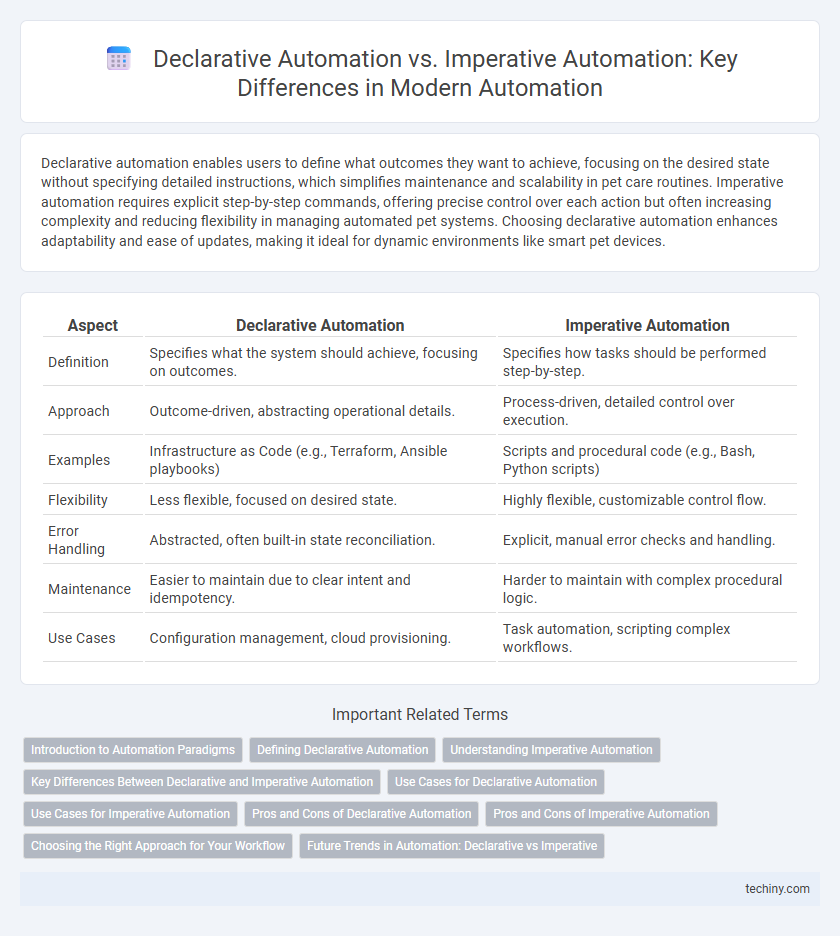Declarative automation enables users to define what outcomes they want to achieve, focusing on the desired state without specifying detailed instructions, which simplifies maintenance and scalability in pet care routines. Imperative automation requires explicit step-by-step commands, offering precise control over each action but often increasing complexity and reducing flexibility in managing automated pet systems. Choosing declarative automation enhances adaptability and ease of updates, making it ideal for dynamic environments like smart pet devices.
Table of Comparison
| Aspect | Declarative Automation | Imperative Automation |
|---|---|---|
| Definition | Specifies what the system should achieve, focusing on outcomes. | Specifies how tasks should be performed step-by-step. |
| Approach | Outcome-driven, abstracting operational details. | Process-driven, detailed control over execution. |
| Examples | Infrastructure as Code (e.g., Terraform, Ansible playbooks) | Scripts and procedural code (e.g., Bash, Python scripts) |
| Flexibility | Less flexible, focused on desired state. | Highly flexible, customizable control flow. |
| Error Handling | Abstracted, often built-in state reconciliation. | Explicit, manual error checks and handling. |
| Maintenance | Easier to maintain due to clear intent and idempotency. | Harder to maintain with complex procedural logic. |
| Use Cases | Configuration management, cloud provisioning. | Task automation, scripting complex workflows. |
Introduction to Automation Paradigms
Declarative automation defines the desired outcome without specifying the exact steps to achieve it, enabling systems to interpret and execute tasks based on intent. Imperative automation involves explicit instructions and detailed workflows, directing precise actions to accomplish goals. Understanding these paradigms is crucial for selecting the appropriate automation strategy to optimize efficiency and scalability in various IT environments.
Defining Declarative Automation
Declarative automation defines the desired end state or outcome of a process without specifying the exact steps to achieve it, relying on the system to determine execution. This approach enhances scalability and flexibility by abstracting complexity and reducing manual intervention. Key technologies enabling declarative automation include infrastructure as code tools like Terraform and configuration management systems such as Ansible.
Understanding Imperative Automation
Imperative automation involves explicitly programming each step of a process, specifying the exact commands and control flow required to achieve a task. This approach allows for granular control and customization, making it suitable for complex workflows where precise execution order and conditions are critical. However, imperative automation often demands detailed coding and maintenance, contrasting with declarative automation, which focuses on the desired state rather than specific instructions.
Key Differences Between Declarative and Imperative Automation
Declarative automation focuses on defining *what* the desired outcome is, using high-level instructions that specify end states without detailing the steps to achieve them. Imperative automation requires explicit instructions on *how* to perform tasks, outlining sequential commands to reach the goal. The key difference lies in abstraction level: declarative approaches emphasize the final configuration and rely on the system to manage execution, whereas imperative methods demand detailed procedural control from the user.
Use Cases for Declarative Automation
Declarative automation excels in cloud infrastructure management, where defining the desired end state simplifies deployment and scaling processes. It is highly effective in configuration management for systems like Kubernetes and Terraform, enabling consistent environments without scripting individual commands. Use cases often include automated compliance enforcement and self-healing systems, reducing manual intervention through policy-driven automation frameworks.
Use Cases for Imperative Automation
Imperative Automation excels in use cases requiring precise control over sequential processes and conditional logic, such as complex ETL pipelines, custom API orchestration, and dynamic workflow management. It allows developers to specify exact commands and execution order, making it ideal for scenarios with unpredictable environments or frequent changes. Industries like finance, healthcare, and manufacturing benefit from imperative automation to handle error-prone tasks and real-time process adjustments.
Pros and Cons of Declarative Automation
Declarative automation simplifies workflows by focusing on the desired outcomes rather than the specific steps to achieve them, reducing complexity and enhancing maintainability. It improves scalability and resilience since the system automatically enforces the target state, minimizing errors caused by manual intervention. However, declarative automation can be less flexible in handling dynamic, real-time conditions and may require more sophisticated tools and knowledge upfront compared to imperative automation.
Pros and Cons of Imperative Automation
Imperative automation offers precise control over task execution by defining specific instructions and sequences, enabling tailored workflows that adapt to complex scenarios. However, it often requires extensive coding effort and maintenance, leading to increased potential for errors and reduced scalability compared to declarative approaches. The rigid nature of imperative automation can limit flexibility, making modifications and updates more time-consuming in dynamic environments.
Choosing the Right Approach for Your Workflow
Declarative automation emphasizes the desired outcome by specifying what the system should achieve, making it ideal for complex workflows with clear goals and dynamic variables. Imperative automation focuses on step-by-step instructions, offering precise control preferred in scenarios requiring detailed task sequences and predictable environments. Selecting the right approach depends on workflow complexity, flexibility needs, and the level of control required, ensuring optimal efficiency and scalability.
Future Trends in Automation: Declarative vs Imperative
Future trends in automation emphasize a shift towards declarative automation, which prioritizes defining desired outcomes over explicit instruction sequences, enhancing flexibility and scalability. Declarative automation leverages AI and machine learning to interpret high-level goals, reducing the need for manual coding inherent in imperative approaches. This evolution supports more adaptive, resilient systems capable of autonomously optimizing workflows in dynamic environments.
Declarative Automation vs Imperative Automation Infographic

 techiny.com
techiny.com